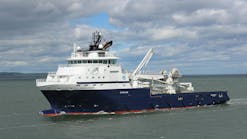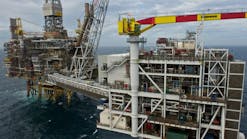Petrobras, as operator of the Libra block consortium, has started contracting suppliers to design, construct, install, and test its patented HISEP technology. This is designed to separate and reinject on the seabed gas with high CO2 content produced with oil.
The contracting process follows conceptual evaluations and pilot tests onshore, in which the company and its suppliers conducted studies and performance validations for the subsea pumps that will reinject CO2-rich gas into the reservoir.
Petrobras aims to select its preferred manufacturer by August 2022, with the equipment then installed in 2025.
According to the company, HISEP could open up deepwater and ultra-deepwater oil production in regions featuring reservoir fluids with a high gas-to-oil ratio and CO2 content. HISEP is designed to increase oil production by freeing up space that would otherwise be occupied in the topsides gas processing plant.
Pilot testing is planned for the Mero 3 area in the Libra block in the presalt Santos basin offshore Brazil, which is due to start production in 2024. After two years of testing, and with the technology proven, it could be deployed in other areas off Brazil such as Libra Central and Jupiter.
Once proven, it should also be possible to develop offshore production platforms with smaller and less complex gas processing plants, Petrobras added, with lower construction and operating costs.
Other partners in the Libra consortium are Shell (20%), TotalEnergies (20%), CNPC (10%), and CNOOC (10%). The consortium is managed by Pré-Sal Petróleo.
Saipem wins Yellowtail, Scarborough contracts
Saipem has received two contracts in Guyana and Australia that are worth a combined $1.1 billion.
Esso Exploration and Production Guyana awarded the company an EPCI contract for the SURF equipment for the Yellowtail development in the Stabroek block offshore Guyana. Water depth is around 1,800 m (5,905 ft). Assuming authorizations from Guyana’s government and investment approval, Saipem will start initial engineering and procurement activities in order to proceed with the program.
Yellowtail will feature new subsea drill centers, each with separate oil production, water injection and gas injection wells, linked to a new FPSO. The company’s fabrication facility in Guyana will construct the deepwater structural elements for the umbilicals, risers and flowlines, with the FDS2 vessel handling offshore installations.
In addition, Saipem has received the notice to proceed from Woodside Energy for a pipelay contract for the Scarborough project in the Carnarvon basin offshore Western Australia. It will undertake coating, transportation, and installation for the 430-km (267-mi), 36/32-in. trunkline, which will connect to the new Train 2 at the Pluto LNG onshore complex. The first cargo should be delivered in 2026. Maximum water depth is 1,400 m (4,593 ft): Saipem will also fabricate and install various line structures and the pipeline end termination in 950 m (3,117 ft) of water. Offshore operations, to be performed mainly by the Castorone vessel, should begin in mid-2023.
Subsea drones tested offshore France, Norway
TotalEnergies has partnered with iXblue and Teledyne Marine to demonstrate collaborative uncrewed capabilities for subsea inspection and asset survey operations. They recently conducted trials offshore La Ciotat in southern France. During the trials, iXblue’s DriX uncrewed surface vehicle (USV) and Teledyne’s Gavia AUV were remotely controlled and supervised from an onshore control center. The DriX USV acted as a communication gateway between iXblue’s onshore control center and the Gavia AUV. The two drones were able to successfully communicate thanks to the Gaps USBL positioning system installed within the DriX gondola and that tracked the Gavia AUV.
Mathieu Lardeux, R&D Project Manager at TotalEnergies, said: “This opens up great possibilities for future multi-energy offshore developments. Replacing the use of conventional large, crewed inspection and survey vessels with uncrewed solutions such as the DriX USV will allow us to reduce offshore risk for personnel, decrease operational costs, and lower the carbon footprint of our offshore operations.”
In addition, Forssea Robotics and DeepOcean have tested an autonomous inspection drone (AID) for Aker BP on subsea templates at the Skarv field in the Norwegian Sea. The location is 210 km (130 mi) offshore in a water depth of around 400 m (1,312 ft).
The AID combines subsea positioning and navigation systems, with software developed by Forssea Robotics to enable dynamic positioning, auto-docking, path-following, and object-tracking modes. DeepOcean’s 3D mission planner pre-programmed the inspection track.
According to Forssea, accurate repetition of an inspection path over a subsea structure allows improved analysis of conditions for integrity management. Also, tasks can be performed more efficiently through simultaneous work during subsea operations, reducing the number of days required for the offshore program and intervention costs, with remote control from onshore centers lessening risks to offshore personnel.






